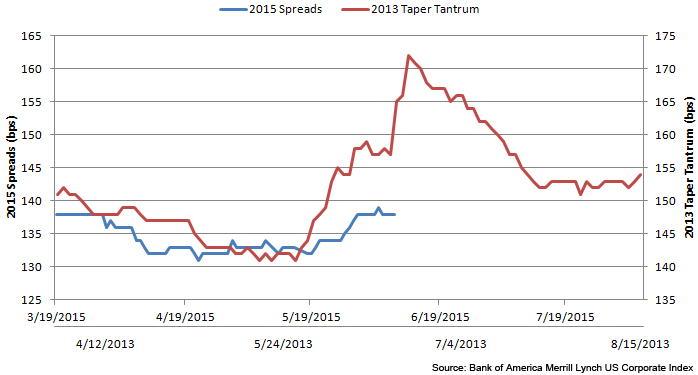This week's chart depicts the credit spread levels of investment grade (IG) bonds today versus how these credit spreads behaved two years ago as the market started to price in the conclusion of Federal Reserve quantitative easing. This chart also provides a framework regarding the potential direction of credit spreads in the second half of 2015.
To date, while IG credit has underperformed high yield credit and most structured product sectors, it has behaved relatively well with a modest amount of volatility. This despite rising Treasury rates, a record amount of M&A activity, and record new issuance. However, the narrow trading range may be disrupted if economic data, particularly labor markets and wage inflation, continue to exhibit strength, and yields on German Bunds remain near their current levels. This would enable the Fed to begin raising rates at its September meeting. This is my base case, and observing market behavior during the 2013 'taper tantrum' is instructive to how we are positioning.
As in 2013, credit spreads may be susceptible to widening over the next few months, ultimately tightening as we come into year-end. However, I think the magnitude of the widening and subsequent tightening will be more muted than it was in 2013, smoothing the inverted-V-shaped part of the chart. The reason for a less dramatic spread widening is that Federal Reserve intentions are much better telegraphed today, and, while market participants debate the merits of raising rates, consensus expectations are for a September hike.
Also, I and other yield-sensitive buyers are waiting for better absolute yields which will provide a level of support for credit. The reason for a less dramatic subsequent spread tightening is the idea that the market will immediately start factoring in the timing and magnitude of future rate hikes. If the data supports it, and the onset of the rate tightening cycle begins in earnest, credit spreads may not retrace to current levels.
One wildcard to the magnitude of spread volatility is the often discussed market liquidity, or lack of it. With the dramatic growth in the credit markets over the last few years, much more limited dealer balance sheets, and the growth of exchange trade funds, the risk remains that real money will rotate out of fixed income on a more sustained basis.
Key Takeaway: Long anticipated Treasury rate-driven volatility may finally be upon us as domestic monetary policy normalizes. The combination of higher rates and spread widening will present an attractive buying opportunity.
The material provided here is for informational use only. The views expressed are those of the author, and do not necessarily reflect the views of Penn Mutual Asset Management.
This material is for informational use only. The views expressed are those of the author, and do not necessarily reflect the views of Penn Mutual Asset Management. This material is not intended to be relied upon as a forecast, research or investment advice, and it is not a recommendation, offer or solicitation to buy or sell any securities or to adopt any investment strategy.
Opinions and statements of financial market trends that are based on current market conditions constitute judgment of the author and are subject to change without notice. The information and opinions contained in this material are derived from sources deemed to be reliable but should not be assumed to be accurate or complete. Statements that reflect projections or expectations of future financial or economic performance of the markets may be considered forward-looking statements. Actual results may differ significantly. Any forecasts contained in this material are based on various estimates and assumptions, and there can be no assurance that such estimates or assumptions will prove accurate.
Investing involves risk, including possible loss of principal. Past performance is no guarantee of future results. All information referenced in preparation of this material has been obtained from sources believed to be reliable, but accuracy and completeness are not guaranteed. There is no representation or warranty as to the accuracy of the information and Penn Mutual Asset Management shall have no liability for decisions based upon such information.
High-Yield bonds are subject to greater fluctuations in value and risk of loss of income and principal. Investing in higher yielding, lower rated corporate bonds have a greater risk of price fluctuations and loss of principal and income than U.S. Treasury bonds and bills. Government securities offer a higher degree of safety and are guaranteed as to the timely payment of principal and interest if held to maturity.
All trademarks are the property of their respective owners. This material may not be reproduced in whole or in part in any form, or referred to in any other publication, without express written permission.


